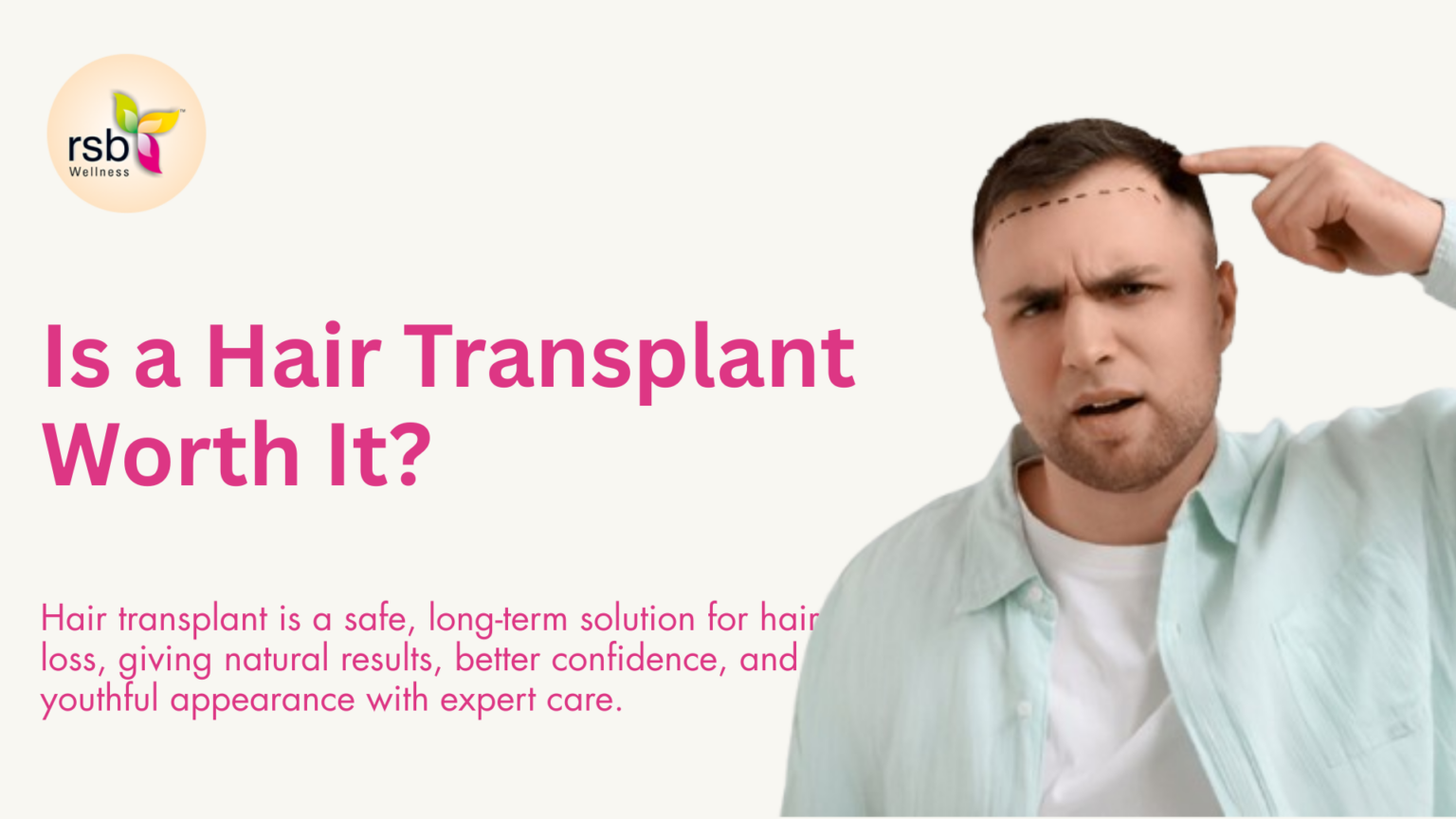Hair transplants are one of the most reliable, long-term solutions for bringing back natural-looking hair. But the real question is — is a hair transplant worth it in terms of results, cost, and recovery?
In India alone, over 2 lakh procedures are performed each year, growing at a steady rate of 15–20% annually. Worldwide, the figure crosses 700,000+ procedures annually, according to the International Society of Hair Restoration Surgery (ISHRS).
With so much buzz, it’s natural to have doubts. Is it permanent? Painful? Really effective? In this guide, we’ll break down everything you need to know — from success rates and healing time to cost, risks, and long-term results — so you can decide if it’s truly worth it for you.
What is a Hair Transplant?
Hair Transplant Explained in Simple Words
A hair transplant is a medical procedure where your own healthy hair, usually from the back or sides of your scalp is carefully implanted into areas with thinning or no hair. It gives you natural, long-lasting results using your own hair, not artificial patches or wigs.
If you’re tired of hiding bald spots, constantly fixing your hairstyle, or feeling self-conscious in social settings, a hair transplant might just be the answer.
Imagine looking in the mirror and seeing your real hair grow back — strong, and natural.

Unlike wigs or hair patches that can slip, need glue, or look fake, a hair transplant offers something real: your own hair, permanently restored. No daily hassle. No maintenance gimmicks. Just results that last and grow with you.
Confused between a hair patch and a hair transplant? Let’s simplify it
– Hair Transplant Vs Hair Patch
| Point | Hair Transplant | Hair Patch |
|---|---|---|
| 1. Natural Look | Grows like your natural hair | Can look artificial on close look |
| 2. Permanent Solution | One-time, long-lasting result | Temporary fix, needs regular replacement |
| 3. Hair Growth | Real hair grows back in transplanted areas | No growth – just covers bald spots |
| 4. Comfort | Fully comfortable, no itching or glue | May cause irritation, needs glue/tape |
| 5. Maintenance | Low – follow normal hair care | High – regular servicing and cleaning required |
| 6. Confidence Factor | Boosts self-esteem with real, lasting change | May feel insecure due to unnatural appearance |
| 7. Cost in Long Term | One-time cost with lasting value | Repeating costs over time become more expensive |
Types of Hair Transplant
Types of Hair Transplant Methods
Hair transplant methods have come a long way. Today, the three most widely used techniques — FUT, FUE, and DHI — offer safe, natural-looking results depending on your hair loss pattern and personal goals.
– FUT (Follicular Unit Transplantation)
Traditional but effective
A thin strip of skin with healthy hair is taken from the back of your scalp. The follicles are then separated and implanted into balding areas.
👉 Slightly longer recovery, may leave a small scar, but useful for larger bald patches.
– FUE (Follicular Unit Extraction)
Minimally invasive and more common today
Hair follicles are removed one by one directly from the scalp — no cuts, no stitches. These are then implanted where needed.
👉 Less pain, no visible scar, and faster healing than FUT.
– DHI (Direct Hair Implantation)
The latest and most precise method
Uses a pen-like tool to extract and implant hairs at the same time — without any cuts.
👉 Delivers better density, a more natural hairline, and quicker recovery.
Each technique has its own pros and ideal use cases, based on your scalp condition, hair loss level, and the results you’re aiming for.
📞 Book your free consultation today to get expert advice on the best hair transplant method for your needs and take the first step toward natural, long-lasting results.
It’s not just your hair that needs care—your skin deserves attention too. For bright, glowing, and healthy skin, Hydrafacial is the perfect choice
Glow Starts Here
Refresh, hydrate, and brighten your skin with HydraFacial. One treatment, endless confidence—because your skin deserves the best.
Is a Hair Transplant Worth It?
When Should You Get a Hair Transplant?
If you’re tired of hiding bald spots or feeling less confident due to hair loss, a hair transplant could be the turning point. Done right, it delivers permanent, natural-looking hair that grows just like the rest of your own — restoring both your hair and your confidence.
Unlike hair patches or endless expenses on oils and serums, a transplant is a one-time investment with long-term benefits. But timing matters — most experts recommend waiting until you’re at least 25, when hair loss patterns stabilize. Getting it too early can lead to patchy results as untreated areas may continue thinning.
– You may be a good candidate if:
- You have visible thinning or bald patches
- Hair loss is affecting your daily life
- You have healthy hair in the donor area (usually the back of the scalp)
While it won’t bring back your teenage hairline, it can significantly improve hair density and boost your overall appearance.
– How Long Does a Hair Transplant Take to Heal?
Hair transplant recovery is gradual. While initial healing happens in 7–10 days, full results appear over 6–12 months.
Key aftercare tips:
- Use only doctor-recommended shampoo
- Avoid touching or scratching the area
- Skip alcohol, smoking, and gym workouts for 1–2 weeks
- Avoid tight caps/helmets initially
- Follow all medications and attend checkups

– Pros and Cons of Hair Transplant Surgery
A hair transplant is one of the few solutions that offers real, lasting results. But like any medical procedure, it comes with trade-offs. Here’s a quick comparison to help you decide if it’s worth it for you:
| ✅Pros of Hair Transplant | Cons of Hair Transplant |
|---|---|
| Hair grows for life | Quality treatments can be expensive |
| Blends with your real hair | Poor donor areas can limit success |
| Restores self-image | Final results in 6–12 months |
| No daily fuss | Temporary Hair Shedding |
| Low risk with experts | Itching or swelling may occur |
How Successful Is a Hair Transplant?
What is the success rate of a hair transplant
Hair transplant is considered one of the most effective treatments for permanent hair restoration. On average, the success rate of hair transplants ranges between 85% to 95%, depending on the technique you used and the surgeon’s experience.
The transplanted hair usually starts growing after 3–4 months and gives full results within 9–12 months. The success of a transplant also depends on your scalp health, donor area quality, and how well you follow post-surgery care.
When a transplant is done by a skilled and experienced hair transplant experts , the transplanted hair looks completely natural and lasts a lifetime. However, results may vary. If you’re suffering with advanced baldness or poor donor hair might see limited improvement.
That’s why proper consultation is very important. Overall, with realistic expectations and the right hair transplant experts, hair transplant is highly successful and life-changing for most patients.
Confused If You’re Fit for a Hair Transplant?
Find out if you’re the right candidate with expert guidance—don’t decide blindly. Let’s clear your doubts today!
What Is the Cost of a Hair Transplant?
How Much Does a Hair Transplant Really Cost?
Hair transplant costs can vary widely, and there’s no one-size-fits-all answer. The final cost depends on factors like how many grafts you need, the technique used (FUE, FUT, or DHI), your scalp condition, and the experience of the Hair transplant experts.
Instead of guessing or comparing average prices, the smartest way to understand your actual cost is through a personalized consultation. During this session, our hair transplant experts will assess your hair loss, donor area, and treatment goals to give you a personalize quote.

Conclusion
Is a Hair Transplant Worth It?
A hair transplant can be a life-changing decision if you’re dealing with bald spots, thinning hair, or low self-confidence due to hair loss. With advanced methods like FUE, FUT, and DHI, you can now get natural-looking, long-lasting results that truly feel like your own hair.
It’s not just about looks—it helps you feel more confident at work, social events, and in daily life. Yes, the procedure needs some investment, care, and patience, but the long-term results are often worth it.
Before deciding, make sure to consult a trusted hair transplant expert. They’ll guide you on the best method, expected results, cost, and recovery based on your condition.
With the right clinic and realistic expectations, a hair transplant can restore more than just hair—it can restore your confidence and bring back your real smile.
Frequently Asked Questions
Is a Hair Transplant Worth It?
Is a hair transplant painful?
No, the procedure is done under local anaesthesia, so you won’t feel any pain. Some people may feel mild discomfort, tightness, or swelling after the procedure, but it usually goes away within a few days with proper care.
How long does it take to see full results?
Initial hair growth begins around 3 to 4 months, but full, natural-looking results typically appear between 9 to 12 months after the transplant. The timeline may vary slightly depending on your healing and hair growth rate.
Are hair transplant results permanent?
Yes, the results are considered permanent because the hair is taken from donor areas that are resistant to hair loss. However, maintaining a healthy lifestyle and following aftercare instructions are important for long-lasting results.
Can women also get a hair transplant?
Yes, women with thinning hair or bald patches can undergo hair transplant, depending on the cause of hair loss. A proper evaluation by a hair expert is necessary to determine the right treatment plan and ensure the best outcome.
What is the best age for a hair transplant?
The ideal age is after 25, as your hair loss pattern becomes more stable by then. Getting a transplant too early might lead to uneven results later if the untreated areas continue to lose hair over time.
Are there any side effects after hair transplant?
Mild redness, swelling, scabbing, or itching are common and usually go away in a few days. Serious side effects are very rare if the procedure is done by an experienced and certified hair transplant expert.
Will people know I had a transplant?
No, once your new hair starts growing, it blends naturally with the rest. If the procedure is done properly by skilled experts, it becomes almost impossible for others to tell that you had a hair transplant.

